ClickUp is a popular collaboration and project management tool, but it’s not the best option for every team. If you’re looking for ClickUp alternatives to meet the growing demands of an increasingly dynamic project management landscape, you’ve come to the right place.
If you’re in the market for a ClickUp alternative, you’ve probably discovered that it’s not quite the right fit — and that’s no fault of your own. The overwhelming array of project management software available makes this decision difficult — and it will only become more challenging. In fact, experts predict the project management software market will reach $15.08 billion by 2030.
With so much money changing hands over project management software, it’s crucial that we all find our perfect tool. In this guide, we’ll take a closer look at the top eight ClickUp alternatives.
But first, let’s look at the criteria you might use to choose the right ClickUp alternative for your team.
Boost your team’s efficiency with Hubstaff's productivity tools
How to Choose the Right ClickUp Alternative for Your Team
To narrow down your list of project management tools, you’ll need to establish the key features you need from a project management tool. You can focus on these key areas as a starting point.
Assessing Your Team’s Unique Needs
There is no best project management tool. A dev team might choose Jira. Maybe a marketing team will end up using Asana. These choices are based on need, not quality. That’s why understanding your team’s needs is crucial. Here are a few areas to think about:
- User interface (UI) and usability: One complaint teams have about ClickUp is that it’s difficult to use. Is your team tech-savvy, or will they need an intuitive interface?
- Support: If there is a learning curve, is customer service available if you need them? Does the platform offer free tutorials and support documents to help your team with onboarding?
- Pricing: Another reason to seek alternatives is price. Is your team on a budget? Or do they have the green light to spend a little more? ClickUp is a powerful tool, but there are cheaper alternatives with similar features.
Matching Features with Project Requirements
Once you’ve identified your team’s needs, it’s time to match features with project requirements. Here are a few things to consider.
- Features: Features are exciting, but they’re only half the equation. Do you need recurring tasks or team collaboration features like ClickUp’s Docs? What about timesheets, invoices, or work orders? Identify project requirements and decide what you don’t need and can’t live without.
- Project requirements. Are you managing projects internally? What about clients? When you attack software decisions from this perspective, you might find you need real-time budgeting features to keep key stakeholders in the loop.
- Comparison to ClickUp: How comparable is each tool to ClickUp? Could the tool replace ClickUp? Does the tool have features that ClickUp doesn’t?
Considering Scalability and Growth
Even after you cross reference project requirements with the features of the tools you’re considering, that only addresses current needs. Where do you see your team heading in the future?
- Scalability: Is your team experiencing considerable growth? Are you transitioning to fully remote work? This could impact which ClickUp alternative you choose.
- Integrations: Based on your answers to the previous questions, what integrations will you need? Check each platform’s integrations page to ensure your most used tools are on the list.
8 top alternatives to ClickUp
ClickUp markets itself as one app to replace them all. With to-do lists, time tracking, screenshots, and recording, it’s hard to argue with their logic. But can one app replace ClickUp?
Let’s find out. First up, Hubstaff Tasks.
1. Hubstaff Tasks
Hubstaff Tasks is a powerful task management platform with many of the same features that ClickUp offers. The user-friendly, intuitive interface requires little to no training for employees.
At Hubstaff, we use Tasks to handle project management and team collaboration for our entire organization. We use the Stand-up feature to handle projects and check in with team members without daily meetings or constant contact.
Features
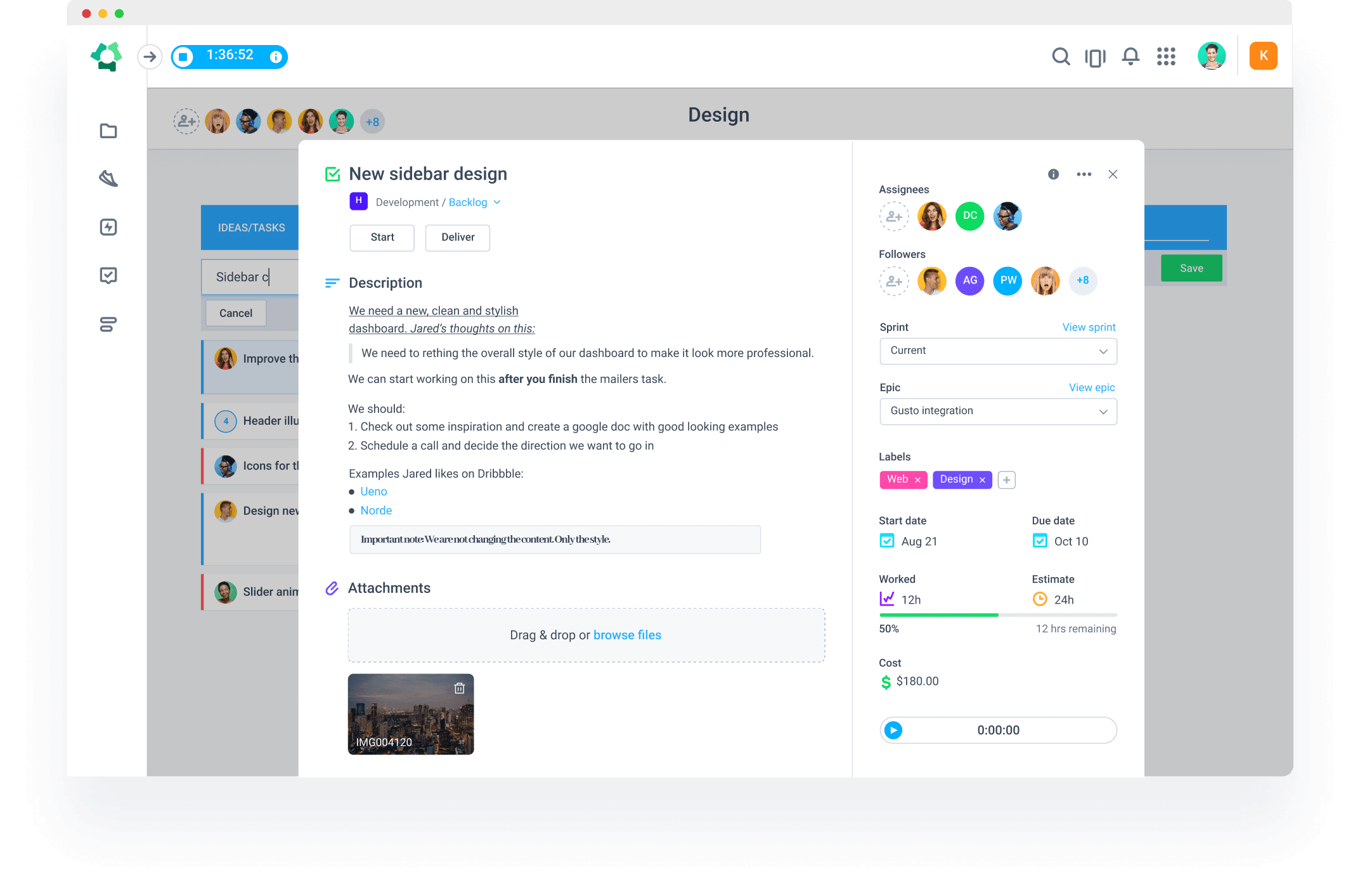
- Sprints. Organize workloads into Agile Sprints with an intuitive drag-and-drop interface.
- Change views. Toggle between Sprint view, Kanban-style boards, timelines views, and more.
- Set task dependencies. Set up task dependencies, relationships, and blockages. Or check the entire project cycle with the Roadmap tool.
- Workflows. Create and manage customizable workflows to take Agile project management to new heights for your team.
- To-do lists. Create personal to-do lists to stay on top of your work at all times.
- Time tracking. Track time to projects, tasks, and more. You’ll have a real-time glimpse to track progress with hours worked, costs, and more.
Additional features
- Agile workflows
- Automated Stand-ups
- Epics
- Roadmaps
- Project Timelines
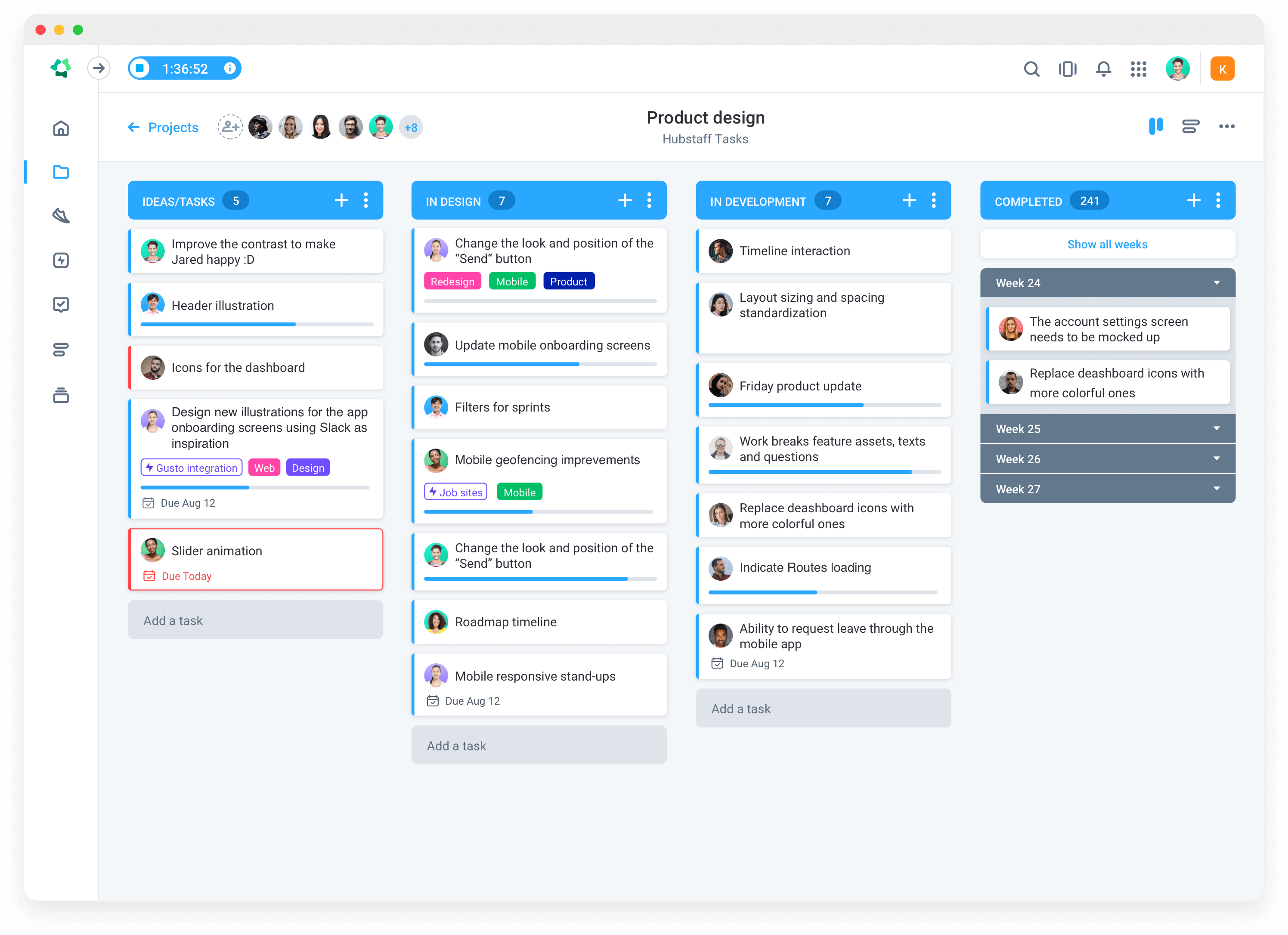
Pricing
- Free plan: Free
- Premium plan: $5 per user/month
- Add-on: Tasks is included as an add-on for Hubstaff Grow, Team, and Enterprise plans.
2. Monday.com
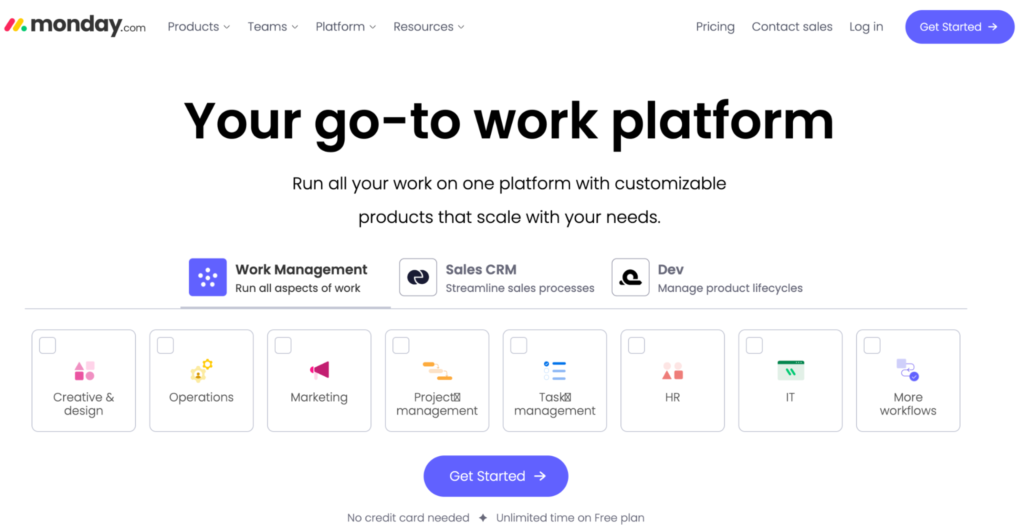
Pricing
- Personal plan: Free
- Starter: $10.99
- Advanced: $24.99
- Enterprise: Contact Monday for pricing
Monday.com is a powerful project management solution with plenty of customization. Pre-made templates ensure you’ll never need to start from scratch. You can create workspaces custom-tailored to your industry, job responsibilities, and more.
Users also acknowledge that monday.com’s UI is aesthetically pleasing and clean. Once you know how to use it, it’s less overwhelming than ClickUp. That said, no tool is perfect.
“Somehow, the simple UI is not very intuitive for me. The rows display of items seems a bit off as opposed to the boards display. That also makes the screen seem full of tasks that are usually irrelevant for some users.”
– Harrel M
Leisure, Travel, and Tourism
(Via GetApp)
Features
- Pre-made templates: Tweak pre-made templates to custom-tailor work to your liking. Monday.com has templates for virtually any industry, job responsibility, or use case.
- Project boards. Monday.com has some of the most beautiful project boards. You’re in control of how you visualize tasks, deadlines, assignees, and more with 30+ customizable widgets.
- Communication and collaboration. Comments, discussion threads, tagging files, and file sharing make for a well-rounded communication feature set.
- Integrations. Monday.com offers 200+ integrations with apps like Gmail, DocuSign, Mailchimp, and Slack.
Additional features
- Dashboards
- Integrations
- Automations
- Gantt charts
- Kanban boards
- Docs
- Files
3. Asana

Features
- Customizable views. Seamlessly shift between sheets, timelines, calendars, Gantt charts, and other views without creating new projects.
- Rules. Create custom rules to assign collaborators, move to new Kanban stages, create subtasks, and more.
- Goal setting: Create and start pursuing goals and objectives. Then, set up a detailed reporting dashboard to track project progress.
- Integrations. Asana offers integrations with Google Drive, Slack, Salesforce, Hubspot, and more of your favorite tools.
Additional features
- Workflow builder
- Gantt chart and Kanban boards
- App integrations
- Reporting
- Strategic goals
- Automation
- Workload management
Pricing
- Basic plan: Free forever
- Premium plan: $13.49 per user/month
- Business plan: $30.49 per user/month
- Enterprise plan: Contact the Asana sales team
Asana is a work management platform for web and mobile that can help teams better organize and manage their work.
I’ve used Asana extensively as a team project management tool. In my opinion, Asana was much easier to use and had many of the same features as ClickUp. For this reason, Asana is one of my favorite project-planning options.
Asana is known for its ease of use and straightforward UI. This is one area where I think Asana far exceeds ClickUp. Others tend to agree.
“Overall, I love that Asana is super easy to use, but also has more advanced features when you need them.”
Rebecca B.
Marketing and Advertising
(Via GetApp)
4. Hive
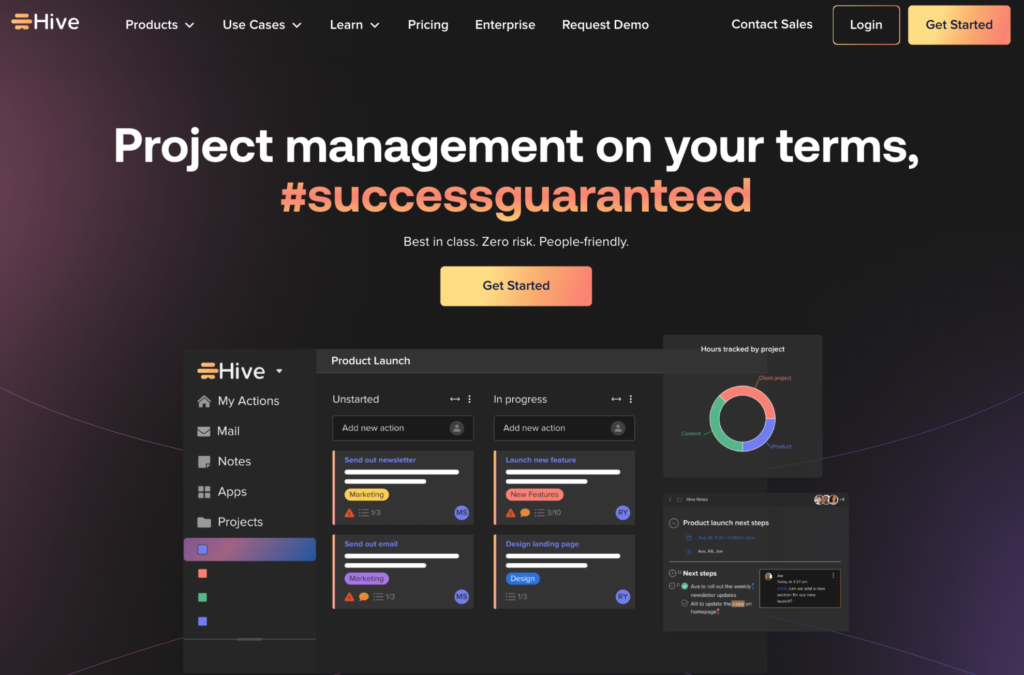
Hive is a project management tool that has features similar to those of other tools on this list. It offers time tracking, an array of project views, and even a notes app that serves as a simplified version of ClickUp’s docs feature.
What really sets it apart is the integrated email inbox and team chat features. You can easily discuss task-related work directly in Hive the way you would in Slack, Teams, or another tool.
Main features
- Integrations. There are over 1,000 integrations to choose from to help you optimize your efficiency.
- Time Tracking. Track time to projects and see how much time you’re spending on them.
- Messaging. Message teams with a built-in instant messaging interface for better collaboration and communication.
- Notes. Create meeting agendas, set goals, and keep your own private notes.
Additional features
- Customizable dashboards
- Project templates
- Mobile proofing
- Workflow automation
Pricing
- Solo plan: Free
- Teams plan: $12 per user/month
- Enterprise plan: Contact the Hive sales team for help
5. Jira
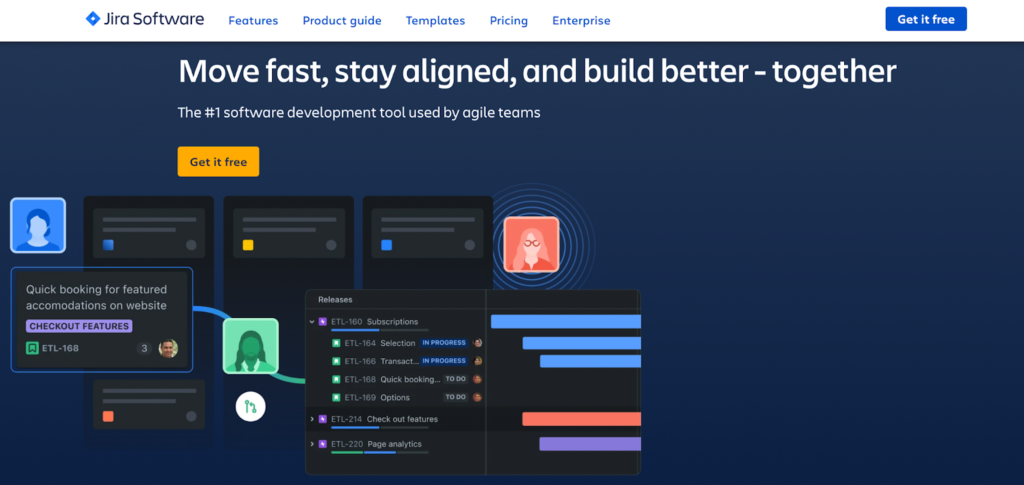
Jira is a task tracking suite specifically designed for those following the Agile project management methodology. Like ClickUp, Jira users can begin their projects with a ready-made template. Then, they can break workloads into more manageable projects with users’ stories, tasks, and issues.
“What I always disliked about Jira is the lack of UI customization, such as applying themes or having certain sections stand out more than others. You will see much of the UI is plain and ambiguous.”
Prince K.
Telecommunications
(Via GetApp)
Main features
- Agile workflows. Jira is made for Agile, and the feature set follows suit. You’ll have no trouble managing tasks with Scrum, Kanban, sprints, and other Agile staples.
- Integrations. Agile can hang with the best of them in terms of integrations. The Jira marketplace offers over 3,000 integrations with tools like Slack, GitHub, Miro, and Figma.
- Reporting. Jira offers out-of-the-box Agile reporting that will help you share your performance with management, clients, and other key stakeholders.
- Templates. Jira isn’t just for developers. Work from pre-made templates for Human Resources, Finance, Marketing, and more.
Additional features
- Scrum boards
- Roadmaps
- Drag and drop automation
- Open DevOps
Pricing
- Free plan: Free
- Standard plan: $7.50 per user/month (on average)
- Premium plan: $14.50 per user/month (on average)
- Enterprise plan: Enterprise pricing information is available when you have 801 or more users
6. Wrike
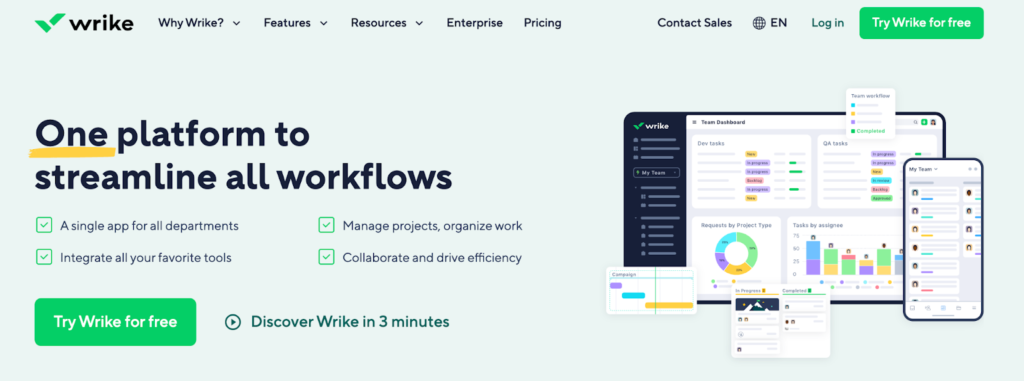
Wrike is a customizable project management application that can streamline complex projects and communication. With project templates, you can jump right into creating projects. You can customize dashboards, workflows, and forms to optimize Wrike for your team.
If you’re looking to scale your team and you’re outgrowing ClickUp, Wrike is great for large or enterprise-level businesses. With over 400+ integrations, it can keep pace with a growing team that’s constantly expanding its tech stack.
Main features
- Task management: Create, assign, and execute on tasks with ease. Sort them into folders, add subtasks, and set milestones to knock out your goals.
- Gantt charts: Work with the classic Gantt chart format to visualize project timelines, task dependencies, and more.
- Cross-tagging. Tag tasks as they relate to your team across projects to see how they fit into company-wide goals.
- Dynamic request forms. Route requests from one central location to ensure clients have access to the same data
Additional features
- Kanban boards
- Templates
- Time tracking
- Analytics
- Project portfolio management
- To-do lists
- Invoicing
Pricing
- Free plan
- Professional plan: $9.80 per user/month
- Business plan: $24.80 per user/month
- Enterprise plan: Contact the Wrike sales team
7. Nifty
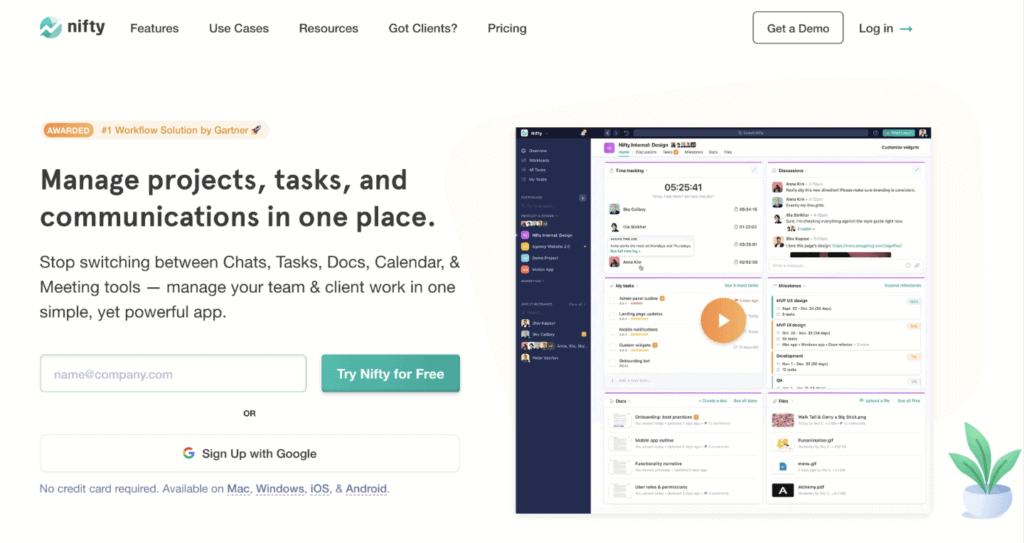
Nifty is a collaboration tool that helps teams manage projects, tasks, and communication in one central location. It has a straightforward, clean UI that makes it great for teams that are eager to jump in and start managing projects.
Features
- Discussions. Like other tools on this list, Nifty allows you to chat directly within the app without having to resort to apps like Slack and Teams. The best part? You can convert these discussions into tasks so nothing slips through the cracks.
- Docs. Nifty has built-in wiki capabilities to help you create a knowledge base of documents for your team and store important project information and documentation in Nifty for reference.
- Integrations. You can connect with Nifty using your web browser, Android, iPhone, or iPad. Then, you can choose from over 2,000 integrations to connect with Nifty.
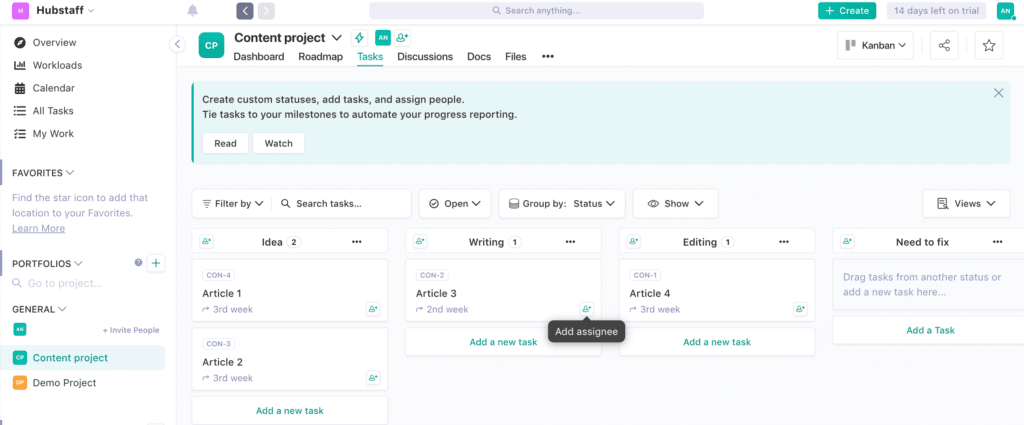
Additional features
- Milestones
- Time tracking
- Reporting
- Project portfolios
Pricing
- Free plan: Free
- Starter plan: $5 per user/month
- Pro plan: $10 per user/month
- Business plan: $16 per user/month
- Enterprise plan: Contact the Nifty sales team for enterprise pricing
8. Airtable
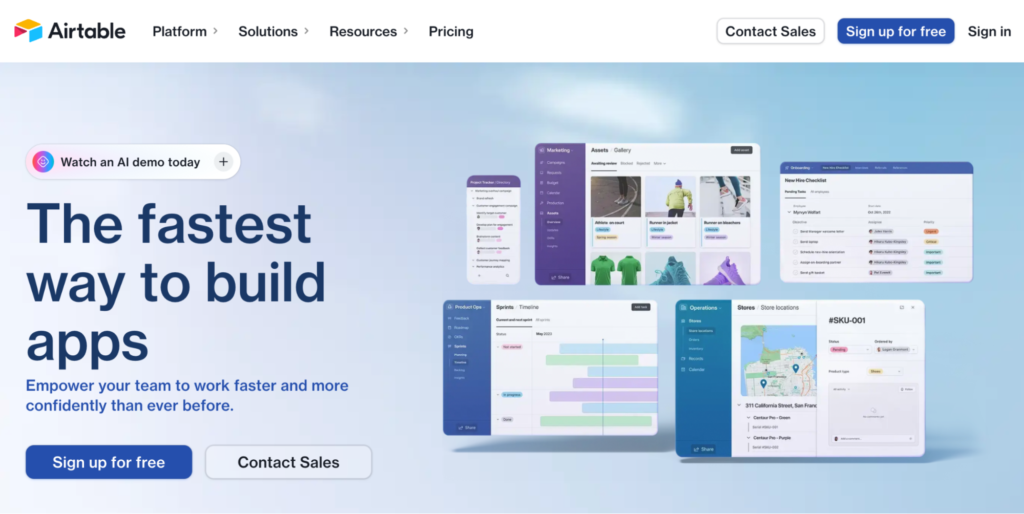
These days, Airtable considers itself an app-building tool — which might be a bit overkill coming from ClickUp. That said, we managed our entire Hubstaff SEO presence in Airtable for a while, and it worked pretty well.
Airtable is a sheet-building tool, first and foremost. While that’s not always so great for project management, Airtable is so customizable that you can really tweak it to the unique needs of your business.
Features
- Workspaces. Create your own custom workspaces. Design them as sheets, Kanban boards, calendars, or anything else you dream up.
- Integrations and data syncs. You can sync data across different workspaces to grow your processes. Integrations can also help you sync data from other tools to your base.
- Forms. Create sharable forms that populate records in your tables. You can share them with anyone on your team to help you fill in the blanks.
Additional features
- Automations
- Reporting
Pricing
- Free plan: Free
- Plus plan: $10 per user/month
- Pro plan: $20 per user/month
- Enterprise plan: Contact the Airtable sales team for an enterprise quote
9. Backlog
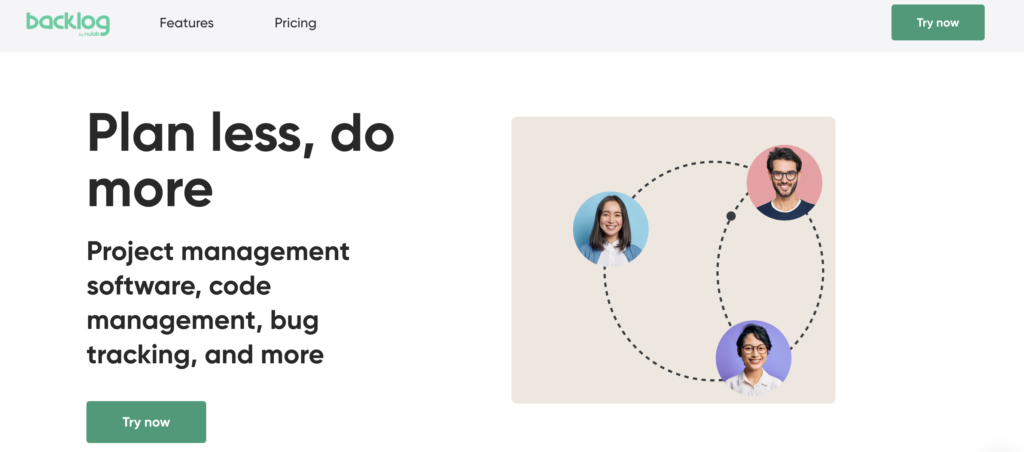
Backlog is yet another ClickUp alternative that functions primarily as a project management tool. However, what really sets it apart is that it’s uniquely catered to dev teams. Built-in code management features paired with project management staples like boards and Gantt charts make Backlog a coder’s dream.
Features
- Project management. Manage your work with boards, Gantt charts, burndown charts, and more.
- Code management. Use built-in code management features to manage pulls, merges, and branches. Backlog also offers built-in Git and SVN repositories.
- Wikis. Create custom wikis to keep process documentation, product knowledge, and more in one central location.
Additional features
- Gantt charts
- Boards
- Burndown charts
Pricing
- Free: $0 per month
- Starter: $35 per month for up to 30 users
- Standard: $100 per month for unlimited users
- Premium: $175 per month for unlimited users and projects
Final words
Introducing new project management software into your workspace can improve your teamwork, organize your task list, and maximize resource management.
ClickUp’s paid plan can get expensive, and its interface can be difficult for users. If ClickUp isn’t working for you, try one of these tools to boost your team’s project management.
Subscribe to the Hubstaff blog for more posts like this

Most popular
The Critical Role of Employee Monitoring and Workplace Security
Why do we need employee monitoring and workplace security? Companies had to adapt fast when the world shifted to remote work...
15 Ways to Use AI in the Workforce
Whether through AI-powered project management, strategic planning, or simply automating simple admin work, we’ve seen a dramatic...
The AI Productivity Panel: Lessons From Leaders on What’s Working (and What’s Not)
When I moderated this AI productivity panel, I expected a solid conversation. What I didn’t expect was the flood of real-world i...
Employee Performance Dashboards: Templates, Tools, and Best Practices
Keeping track of how your team’s really doing can be tricky. Spreadsheets pile up, one-on-ones only tell part of the story, and...




